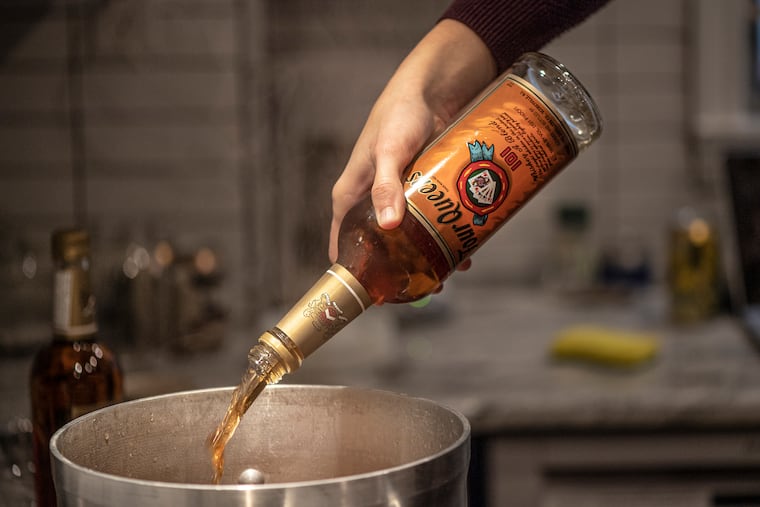N.J.’s Four Queens whiskey fuels boilo, a Christmas tradition in Pennsylvania’s coal country
“It’s like the tie you find in your father’s closet that’s not in vogue but somehow came back again.”

SCOBEYVILLE, N.J. — The closest coal mine is more than 100 miles to the west, across the river and up into the hills of northeastern Pennsylvania. But each year, just after Thanksgiving, a central New Jersey distiller sees an enormous sales spike in one of its lesser-known products out in coal country.
Monmouth County’s Laird & Company — best known for its eponymous applejack — distributes its products nationwide. In the scheme of its portfolio, Four Queens whiskey plays a minor role: It sells only about 36,000 bottles each year. (Jack Daniel’s, by comparison, sells an estimated 160 million-plus bottles of whiskey a year.) But 98% of Laird’s Four Queens sales are in Pennsylvania, specifically in Schuylkill, Luzerne, Berks, Dauphin, and Lehigh Counties.
“When I first saw the sales, I thought: ‘What the hell is going on here? Why do these spike so much?' ” said Tom Alberico, director of sales and marketing at Laird’s. "I thought, ‘What are they doing with all this Four Queens?’ ”
Four Queens, a blended whiskey, is the main ingredient in boilo, a concoction that’s been a holiday staple in Pennsylvania’s anthracite coal region for close to a century. It’s been gaining profile, earning the nickname “the Champagne of Schuylkill County,” where there are contests devoted to the drink.
Boilo — often boiled in a large pots, hence the name — is modeled on a honeyed Lithuanian and Polish liqueur (krupnikas and krupnik, respectively), a carryover from the early 20th century, when immigrants from both countries poured into Pennsylvania’s hills during the anthracite boom.
The homemade brew starts by combining ginger ale or water with copious amounts of honey, quartered oranges and lemons, and warm spices (caraway, cloves, cinnamon). It simmers for several minutes to make a spicy base that’s strained before adding booze. It’s served warmed, often with raisins. It’s sweet and, thanks to Four Queens, very strong.
“Four Queens is the staple,” said Helga Loncosky, a Northumberland County resident who has a YouTube cooking channel dedicated to Pennsylvania cooking.
So why is Four Queens the alcohol of choice? Alberico has two guesses: It’s strong — 101 proof — and it’s cheap. Most 80-proof whiskeys cost more, he said.
“I think you can get a bottle for less than $10,” he said. “It’s a good whiskey.” (It retails for $9.99 in Pennsylvania state stores.)
Coal-region cooks say Alberico’s guess is a good one.
“Four Queens was plentiful and cheap, and it’s not a bad whiskey,” said Lori Fogg, who runs the Coal Cracker in the Kitchen website. “Originally it was moonshine. As it moved away from that, people started using Everclear, but that’s really strong [often 151 proof] and can get you in trouble.”
Four Queens was originally made by Philadelphia’s Kasser Liquors, which Laird bought in 1990. A 1969 Inquirer ad called Four Queens “a man’s blended whiskey,” used often in eggnog and Fish House Punch.
Alberico said 60% of Four Queens’ sales take place between November and February, and this year alone, sales are up 10%. He attributes that to the growing interest in niche cocktails, mixology, and higher-proof spirits.
“It’s like the tie you find in your father’s closet that’s not in vogue but somehow came back again,” he said.
In 2017, Philly-based writer Drew Lazor wrote about boilo for the online beer, wine, and spirits magazine Punch. Lazor made his own batch for the holidays, too, using Four Queens, but he said there’s a slew of different recipes out there.
“I’d say if you like a hot toddy, you will love boilo,” he said. “It tastes like winter.”
Alberico said Four Queens makes up a small percentage of Laird’s sales. They’ve done a little marketing for boilo, trying to push it as a fall and winter drink, but he says it doesn’t have much “sex appeal” in bars. But boilo is why the Pennsylvania Liquor Control Board permits Four Queens to be sold in state stores, Alberico said, and why Laird keeps making the whiskey at all.
“It’s a small percentage of what we sell overall,” Alberico said. “It’s really only sold in Pennsylvania.”
It’s still mostly a drink you make in the kitchen, or the fire hall, often given out jarred as a Christmas present. Some folks add the liquor while the base is boiling, which has lent to boilo’s fiery reputation.
“You might get blown up when you make it,” said Loncosky. She recommends adding the liquor at the end, off heat.
Fogg grew up in Schuylkill County but now lives in Johnstown, in the bituminous coal region west of the Susquehanna River. She said there was no boilo tradition in Western Pennsylvania, but she’s been trying to change that one batch at a time.
“They don’t know boilo out here,” she said.
Fogg’s only recommendation when it comes to boilo, besides Four Queens, is to pace yourself if you brew a batch.
“Sip it in a shot glass,” she said. “You should sip it because, mmm, yeah. It’s wow.”